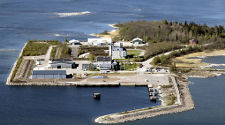
The SFR 1 repository at Forsmark in Sweden is operated by the Swedish Nuclear fuel and Waste Management Company and used for the final disposal of low- and intermediate-level radioactive waste produced by the Swedish nuclear power programme, industry, medicine and research.
It has been receiving wastes since 1988. In 1992 it was granted a full-scale operating permit following the first in-depth safety assessment in 1991. One of the conditions of the licence was that a revised safety assessment should be carried out by SKB at least every ten years during the continued operation of the facility. The first 10-year SKB re-evaluation was submitted to the regulators (The Swedish Nuclear Power Inspectorate, SKI and the Swedish Radiation Protection Authority, SSI) at the end of June 2001.
Quintessa has provided support to SKI in evaluating SKB's case for the post-closure safety of the SFR facility. Quintessa's work has been documented in three SKI reports:
- SKI Report 02:61, "SKB's Project SAFE for the SFR 1 Repository - A Review by Consultants to SKI".
- SKI Report 02:62, "Exploration of Important Issues for the Safety of SFR 1 using Performance Assessment Calculations".
- SKI Report 00:49, "Evolution of Near-Field Physico-Chemical Characteristics of the SFR Repository"
The identification of key issues for the safety case was assisted by the use of independent Performance Assessment (PA) calculations using AMBER; the results of these calculations are described in the second of these reports. The SFR system is complex, partly because the environment is expected to change relatively rapidly over the next few thousand years as the land rises and the Baltic coastline recedes. Although SFR is under the Baltic at the present time, this is unlikely to be the case for the whole of period for which PA calculations are undertaken. This potential environmental change is represented explicitly in the AMBER calculations.
Image Courtesy of SKB